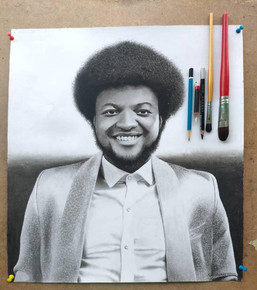Making Ends Meet as a Portrait Artist in Nigeria
- kennethonwurah75
- May 22, 2024
- 3 min read
By Chinonso Kenneth
Abuja, Nigeria.
It was sunny and the heat was searing in Karshi, Abuja as I stepped into Edesco Art, the contemporary art shop where Solomon Sarki draws and paints. The shop is brightly lit, the walls are white and adorned with several compelling paintings.
Canvasses and other drawing materials occupied one part of the shop. Solomon was crouched over a canvass, staring intently, almost absentmindedly at a half completed drawing when I walked in. He smiled when he saw me and offered me a seat.
Solomon Sarki is a portrait and realist artist with love for pastel and charcoal paintings. The second of 3 boys, he began drawing from age five and was encouraged by his father, a secondary school teacher.
“My father used to bring A4 sized paper for me and my brothers because he noticed we liked drawing. We would pick one of our pictures and draw them on the A4 papers,” Solomon explains to Erato Magazine.
As they grew older, the boys continued to draw, supported by their parents. It became a normal occurrence for colleagues of their father to request for Solomon and his brothers to draw and illustrate items for use as teaching aid in the classroom.
Sebastian Sarki, Solomon’s older brother tells Erato Magazine that he decided to focus on more serious academic pursuits, thus, drawing became a distraction. As his passion weaned, Solomon’s continued to grow stronger.
When he turned 18, Sebastian introduced Solomon to Mr. Lawrence Tokumbo, a professional artist and Fine Arts teacher at the Federal Technical College, Orozo, Abuja. Mr. Lawrence mentored Solomon and launched him into the world of professional drawing and painting.
“My parents have always been very supportive; all they want is to see me doing well by whatever means. They saw that I was good at drawing and have been supportive hoping that one day, it will pay,” Solomon tells Erato Magazine.
For Solomon, realistic drawing is his aim, he wants his art to be picturesque and indistinguishable from a photograph taken with a photo camera. For now, Solomon concentrates on painting commissioned pieces from paying clients as passion drawing does not help him fulfill his fiscal obligations.
“Like this one,” Solomon held up a painting of a cat for me to see, “I made it in 2022 and I have been trying to sell it and no one has shown interest. So, I keep all my materials for commissioned works but if I’m financially stable I will do more conceptual and animal paintings,” Solomon says.
While he charges a different fee for each client depending on factors such as the type of painting and the negotiating skill of each client, the most he has been paid for a commissioned portrait is N50,000 ($39).
To make ends meet, Solomon combines his art with creating architectural housing and building models for individuals and organizations, but even getting clients for this is difficult.
“I studied architecture in university, and I love to build models, but unfortunately Nigeria’s economic challenges mean that not everyone who wants to erect a house or building will want a model made for them after the initial architectural design,” Solomon says.
To make his portrait drawing and paintings easier and even more accurate, Solomon uses a mathematical graph to capture the shape and angles of image he wants to draw. The graph helps him extract the correct measurement and the features of the image he is drawing on his canvass which he then traces with either a pencil or charcoal.
When he lacks inspiration, Solomon takes a break to refresh his mind and creative self. However, this only applies to non-commissioned works, for commissioned portrait pieces, Solomon simply shrugs off the mental and/or physical fatigue and finishes the piece.
Holding up the cat painting again, “this one,” Solomon said, ”took me more than two months to finish. Because it was not commissioned, I was just doing it gradually.”























Comments